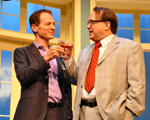I report in today’s Wall Street Journal on Pittsburgh Irish and Classical Theatre’s production of Alan Ayckbourn’s House & Garden. Here’s an excerpt.
* * *
When is a stunt not really a stunt? When it’s dreamed up by Alan Ayckbourn. In addition to being the most prolific playwright of modern times, Mr. Ayckbourn is also a master of ingenuity, as New York audiences discovered two years ago when London’s Old Vic brought its revival of “The Norman Conquests” to Broadway. But “The Norman Conquests,” three interlocking plays set in different parts of the same country house on a single weekend, is far more than just a piece of consummate cleverness. So is “House & Garden,” a 1999 diptych consisting of two plays that take place simultaneously in the sitting room and garden of the same house and are designed to be performed in adjacent theaters by the same cast, with the actors racing from stage to stage as needed. (Only the audiences stay put.)
 “House & Garden” is a high-speed whirligig of theatrical trickery, but as always with Mr. Ayckbourn, there’s more to it than that. In between the riotous farce-style sequences, he paints a bleak portrait of the dilapidated state of modern marriage as seen through the eyes of two unhappy couples, and the funnier the jokes, the darker the shadows. It makes for an impressive package–but one that can only be performed by a company that has access to two stages on the same site.
“House & Garden” is a high-speed whirligig of theatrical trickery, but as always with Mr. Ayckbourn, there’s more to it than that. In between the riotous farce-style sequences, he paints a bleak portrait of the dilapidated state of modern marriage as seen through the eyes of two unhappy couples, and the funnier the jokes, the darker the shadows. It makes for an impressive package–but one that can only be performed by a company that has access to two stages on the same site.
That’s where Pittsburgh Irish and Classical Theatre comes in. Founded in 1996, PICT operates out of the University of Pittsburgh’s Stephen Foster Memorial, a purpose-built theatrical complex that looks like a Gothic-style church. It contains two houses, the 454-seat Charity Randall Theatre and 153-seat Henry Heymann Theatre, that are connected by a backstage spiral staircase, making it possible for PICT to mount “House & Garden” with relative ease. Just because you can do something doesn’t mean you should, but PICT has taken the measure of “House & Garden” and put together a cast whose members are equal to the challenge of conveying its technical and emotional complexities….
* * *
Read the whole thing here.
Terry Teachout on the arts in New York City
An ArtsJournal Blog
